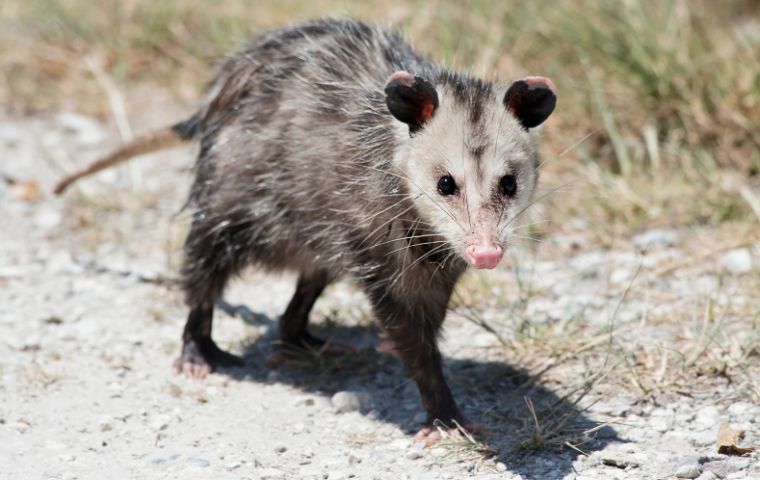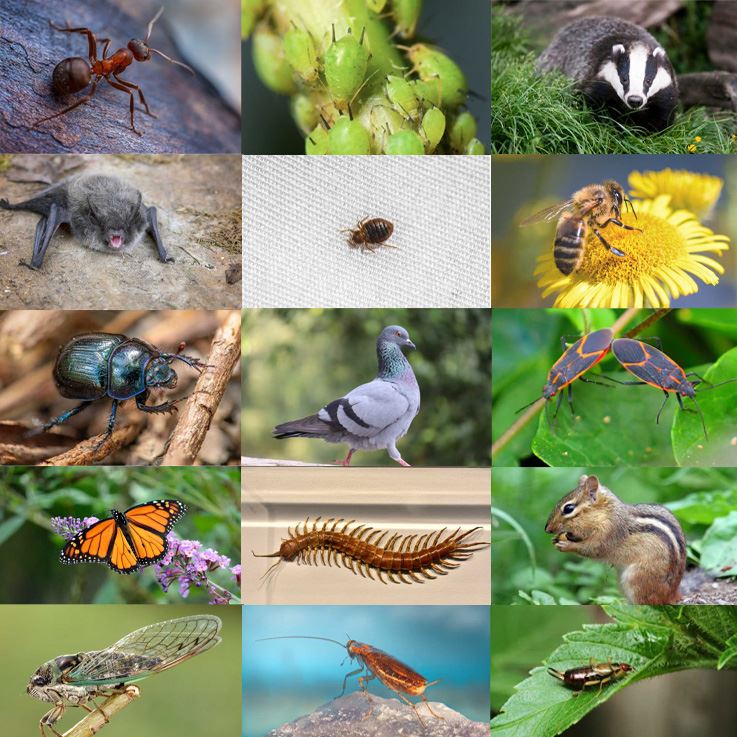
Opossums
What Are Opossums?
North American opossums, often simply referred to as possums, are marsupial mammals that belong to the family Didelphidae. They are the only marsupials native to North America and are known for their unique characteristics and adaptations. Here is an overview of North American opossums:
Are Opossums Harmful?
Opossums may be considered harmful in certain situations, though they are often misunderstood and play an important role in ecosystems. In some circumstances, they can cause issues for humans, pets, and property. Here are several ways in which opossums might be considered harmful:
Pet Safety
- Aggressive Behavior: While opossums are generally shy and non-aggressive, they will defend themselves if cornered or threatened. In rare cases, they may lash out at pets like dogs or cats, particularly if they feel endangered.
- Injuries from Bites: Opossums have sharp teeth and claws, which can result in injuries to pets, especially if the opossum is stressed or feels threatened. A bite from an opossum may also lead to infection if not treated properly.
Property Damage
- Nest Construction: Opossums may seek shelter in attics, crawl spaces, or basements. They often build nests in these spaces, which can lead to structural damage, particularly if they chew on wiring or insulation.
- Shed and Garage Damage: Opossums are known to take refuge in outdoor sheds, garages, and storage areas, where they may damage items or cause a mess.
Health Risks
- Disease Transmission: Opossums are capable of carrying diseases such as leptospirosis, tuberculosis, and toxoplasmosis. They may also harbor parasites like fleas, ticks, and mites, which can transmit illnesses to pets or humans.
- Salmonella and E. coli: These animals can spread bacteria like Salmonella and E. coli through their feces, which could contaminate food sources or water supplies.
Fecal Matter
- Fecal Contamination: Opossums may leave droppings in places like attics, basements, or crawl spaces. These droppings can be a health hazard, particularly in confined spaces where they may not be easily cleaned.
Food Source Contamination
- Garbage Scavenging: Opossums are opportunistic feeders and may rummage through trash cans or pet food bowls, contaminating food with bacteria or waste products. This could lead to health concerns if the food is consumed unknowingly by humans or pets.
Noise and Disturbance
- Nocturnal Activity: As nocturnal animals, opossums are most active during the night. Their movements in attics, walls, or under structures can cause significant noise disturbances, leading to sleepless nights or stress for homeowners.
Traffic Hazards
- Road Traffic: Opossums are known to be frequent road hazards as they often wander across roads at night. This increases the risk of accidents, both for the opossum and drivers.
Despite these potential issues, opossums are also beneficial in many ways, such as controlling insect and rodent populations. When they are causing harm, it's often best to contact wildlife professionals to address the situation safely and humanely.
Learn more: Are Opossums Dangerous?
Learn more: Do Opossums Bite?
Opossum Appearance
Opossums have a distinct appearance that sets them apart from other wildlife. They are medium-sized marsupials with a unique combination of features:
- Body Size & Shape: Opossums are roughly the size of a domestic cat, measuring between 15 to 20 inches long (excluding the tail) and weighing between 4 to 14 pounds.
- Fur & Coloration: Their fur is coarse and typically grayish-white, though some individuals may appear more brown or black. Their underbelly is usually lighter in color.
- Face & Head: They have a pointed snout with a pink nose and small, black, beady eyes. Their faces often have a white or light-colored contrast against the darker fur on their bodies.
- Ears: Their ears are hairless, black, and rounded, often with a slightly leathery appearance.
- Tail: One of their most recognizable features is their long, hairless, prehensile tail, which is used for balance, carrying materials, and even gripping branches when climbing.
- Feet & Claws: Opossums have sharp claws on all four feet, with opposable thumbs on their hind feet that help them grasp and climb.
- Teeth: They have 50 sharp teeth, more than any other North American land mammal, which they may bare when threatened.
Opossums have a somewhat scruffy, rodent-like appearance but are actually marsupials, related more closely to kangaroos and koalas than to rats or mice.
Learn more: What Do Opossums Look Like?
Learn more: What Do Opossum Droppings Look Like?
Opossum Habitats
Opossums are highly adaptable and can be found in a wide variety of environments. You are most likely to encounter them in the following areas:
Urban & Suburban Areas
Opossums thrive in cities and neighborhoods where food and shelter are readily available. They often seek out:
- Backyards & Gardens – Searching for fallen fruit, pet food, or insects.
- Garbage Cans & Compost Piles – Scavenging for food scraps.
- Under Decks, Porches, & Sheds – Using these spaces as shelter.
- Attics & Crawl Spaces – Occasionally nesting in homes if they find an entry point.
Wooded Areas & Forests
Opossums prefer areas with plenty of trees, as they are skilled climbers. They are commonly found:
- Near Hollow Trees & Logs – Using them as nesting sites.
- Dense Brush & Shrubbery – Providing cover and food sources like insects and berries.
Near Water Sources
Opossums are often found near creeks, rivers, ponds, and marshes, where they can find food like frogs, fish, and invertebrates.
Agricultural & Rural Areas
They often roam farms and ranches, drawn to:
- Barns & Livestock Areas – Looking for spilled grain, small animals, or eggs.
- Fields & Crop Areas – Eating insects, fallen fruits, or vegetables.
Roadways & Suburban Streets
Since opossums are nocturnal and slow-moving, they are often seen crossing roads at night, leading to frequent roadkill incidents.
You’re most likely to encounter opossums at night, as they are nocturnal, but they may occasionally be seen during the day, especially if they are hungry, sick, or disturbed.
Opossum Diet
Opossums are omnivores with a highly varied diet, which allows them to thrive in diverse environments. Their diet consists of both plant-based and animal-based foods, making them opportunistic feeders that eat whatever is readily available.
Natural Diet (Wild Opossums)
- Insects & Small Animals – Beetles, crickets, cockroaches, snails, slugs, worms, mice, rats, frogs, lizards, and even small snakes.
- Carrion (Dead Animals) – Opossums are scavengers and will consume roadkill or other deceased animals, helping clean up the environment.
- Fruits & Berries – Persimmons, apples, bananas, grapes, blackberries, and wild berries.
- Vegetation – Nuts, seeds, grains, grass, and leaves.
- Eggs & Birds – Occasionally, they raid birds' nests for eggs or small chicks.
- Amphibians & Fish – If near water, they may consume fish, tadpoles, and amphibians.
Urban & Suburban Diet (Human-Influenced)
- Garbage & Leftovers – Scraps from trash cans, including meat, bread, and vegetables.
- Pet Food – Opossums frequently eat cat or dog food left outside.
- Compost & Garden Produce – They may raid compost piles or consume tomatoes, melons, and other garden vegetables.
Unusual Food Sources
- Ticks – Opossums are known to consume large amounts of ticks, reducing tick populations in their environment.
- Bones & Shells – For calcium, they sometimes gnaw on bones, shells, or even eat roadkill completely.
Opossums' adaptability in their diet is one of the reasons they are so widespread and successful in both wild and urban environments.
Learn more: What Do Opossums Eat?

Opossum Life Cycle
The life cycle of opossums consists of several key stages, from birth to adulthood, with relatively short lifespans compared to other mammals of similar size. Here’s a breakdown of their life cycle:
- Birth (Neonatal Stage): Opossums are marsupials, meaning they give birth to underdeveloped young that continue to grow inside the mother’s pouch. A female opossum gives birth to up to 20 tiny, pink, blind, and hairless babies (each about the size of a jellybean). These newborns must crawl to the mother's pouch (marsupium) immediately after birth to survive. Only about 6–9 usually survive, as the mother has a limited number of teats inside the pouch.
- Pouch Development (Joey Stage) (2–3 Months): Inside the pouch, the babies latch onto a teat and remain there for about 2 months, feeding on the mother’s milk. During this time, they continue to develop fur, eyesight, and basic motor skills.
- Riding on Mother’s Back (3–4 Months): Once large enough (about 3 inches long), the young leave the pouch but still rely on the mother for protection. They cling to her back as she moves around, learning survival skills. Around 4 months of age, they begin exploring more independently but still return to the mother for safety.
- Independence & Juvenile Stage (4–6 Months): At around 4–5 months, the young opossums are fully weaned and start venturing off on their own. By 6 months, they are completely independent, though they are still smaller than adults.
- Adulthood & Reproduction (6–8 Months): Opossums reach sexual maturity at 6–8 months old and can reproduce soon after. Females can have 1–3 litters per year, depending on food availability and climate.
- Lifespan & Death: In the wild, opossums have a short lifespan, usually only 1–2 years due to predators, disease, and environmental dangers. In captivity, they may live 3–4 years, but they rarely exceed this due to their fast-paced life cycle and genetic predisposition for short lifespans.
Opossums’ rapid reproductive cycle and ability to adapt to various environments allow them to sustain their populations despite high mortality rates.

Hear From Our Happy Customers
-
"Exceeds Expectations"
I can’t say enough positive things about this company... The tech that came out, Jarvis went above and beyond my expectations. Thank you guys, I will continue using your services.
- Jake M. -
"Great Communication"
Tech was on time, communication was great, and he accommodated my needs.
- Alonzo W. -
"Very Knowledgeable"
The tech that arrived was courteous, professional, and very knowledgeable. He was Great.
- Uerial I. -
"Professional & Considerate"
I’m pleased with Miche services. Jarvis came today. Professional and considerate. Thank you!
- Judy B. -
"Fantastic & Patient"
Jarvis was fantastic and patient. He answered my questions with an in-depth explanation and addressed all of my areas of concern. Would love for him to be my assigned tech going forward. Well done!
- Yonnette M. -
"Wonderful Service"
Wonderful service. Jarvis is great. Took care of everything I needed. Thank you!
- Henry P.



